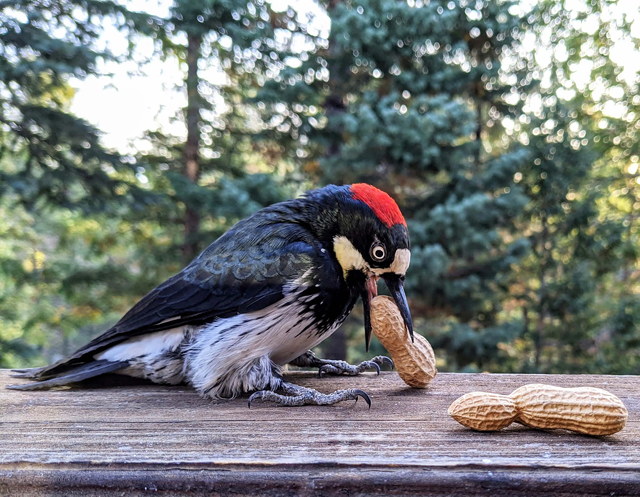

Vicki and her volunteers point out that such casualties are completely preventable if people would keep their cats indoors and exercise greater care and caution when and how they perform such tasks. The Center provides this service to many casualties of tree trimmers, outdoor cats, house tenting and painting. And please consider a tax-deductible donation to the Songbird Care and Education Center. Keep checking our website for future posts about the progress of these birds. This period of transition will allow other Acorn Woodpeckers that already live in the location a chance to to get acquainted with and accept their wannabe neighbors, and vici versa.
#Rehab acorn woodpecker professional
It is the only location within reasonable driving distance where the appropriate habitat exists and such an aviary and professional care is available. The orphans’ next intended home is another rehab center many miles away from where they were first rescued. To release them immediately upon arrival where the species already lives would endanger them unnecessarily. In the past, I've recommended leaving out undyed yarns and animal fur to help birds build their. Why? Because Acorn Woodpeckers live in large family groups and are highly territorial. When an Acorn Woodpecker is found injured or orphaned, it is extremely important to the rehabilitator that the bird is returned within two weeks to the exact colony from which it came, since its place in the commune will be filled by another woodpecker. Nesting season is right around the corner. Mumme Version: 1.0 Published March 4, 2020. LC Least Concern Names (24) Subspecies (7) Walter D. Their introduction to the outdoors will first require about a month in a mobile aviary located in a suitable habitat. Acorn Woodpecker Melanerpes formicivorus Scientific name definitions. Their social lives are endlessly fascinating: they store thousands of acorns each year by jamming them into specially made holes in trees. Though they are already practicing climbing in their plastic crate and occasionally trying to feed themselves, the woodpeckers cannot yet be released. Reminiscent of a troupe of wide-eyed clowns, Acorn Woodpeckers live in large groups in western oak woodlands. The immature birds are now fully feathered and at the appropriate weight. Otherwise glossy-black with streaky underparts. Exhaustive devotion by the volunteers of this non-profit has given them a chance for survival. Medium-sized woodpecker with unique face pattern: red crown, pale yellowish forehead and throat, and pale eye. Until recently the birds needed to be fed about every 15 minutes for 14 hours a day. Both sexes also feed and tend the young.Vicki Andersen and her volunteers from the Songbird Care and Education Center in Orange County, CA have been caring for these three woodpeckers since they were about two days old and became casualties of a tree trimming job in Hacienda Heights. Both sexes incubate the eggs, with males generally taking the night shift. The nests are usually lined with nothing but the woodchips created by excavating the nest cavity, which is excavated by both members of the pair. Most woodpecker species are monogamous, and many form long-term pair bonds. Although they may appear to damage trees, woodpeckers are generally good for tree health because they feed so heavily on wood-boring beetles. Many, especially males, have small patches of red or yellow on their heads. The plumage of most is some combination of black and white, though brown is not uncommon. Most woodpeckers have rounded wings and an undulating flight pattern. A few woodpeckers feed on ants, nuts, or flying insects. The principal food of most woodpeckers is insects, especially the larvae of wood-boring beetles. A special arrangement of bones and elastic tissues allows woodpeckers to extend their long tongues and extract insect prey from the holes they chisel with their strong, sharp beaks.

The specially adapted skulls of woodpeckers allow them to pound hard on tree trunks to excavate nesting and roosting cavities, to find food, and to communicate and attract mates. Most use their strong claws and stiff tail feathers to brace themselves against tree trunks as they climb. Each female lays about 5 eggs, but clutches with more than one laying female can have up to 17 eggs. All eggs are laid in a single nest, which is excavated by both breeders and helpers.

The rest of the group do not breed but help raise the young. Further specialization has produced many aberrant forms with different behavior and feeding habits. Each group of Acorn Woodpeckers has 1 to 7 breeding males and 1 to 3 breeding females. Woodpeckers have many adaptations that allow them to perch upright against tree trunks and feed on insects under the bark or within the wood of the tree itself.


 0 kommentar(er)
0 kommentar(er)
